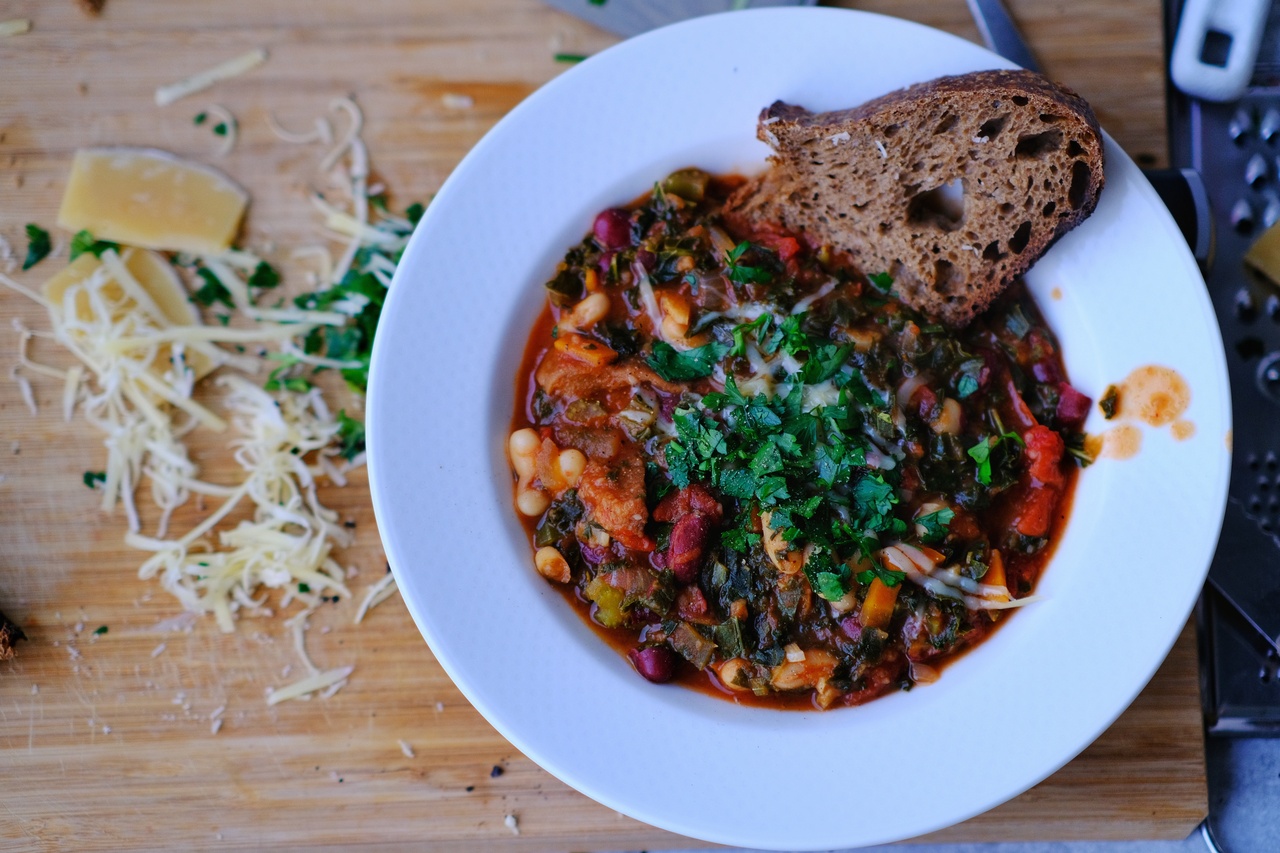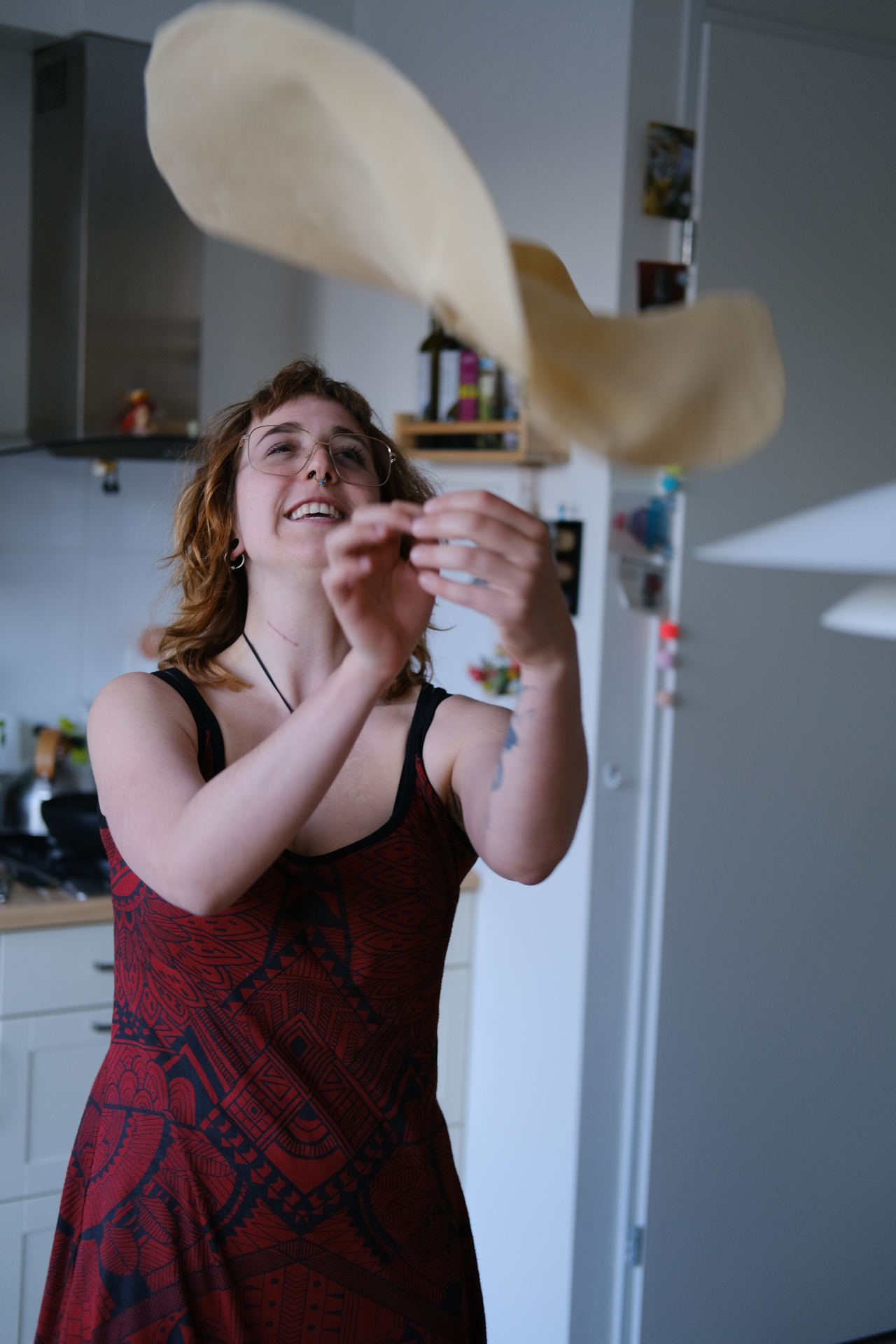Ribollita

Ribollita in my father's kitchen in early autumn, Tilburg, 2021.
Ribollita is a Tuscan peasant soup, traditionally reheated from leftover minestrones and other foodstuffs. Not a glamorous introduction to the rich Italian cuisine, arguably. I've made Italian lasagna's, ragù's, fish-, and vegetable-dishes before, but none of those in the context of this project. So I don't want to include them in my notes (mostly because I don't have pleasing photos yet; no, but really because I just prefer writing my thoughts one-at-a-time in recent-relevant contexts).
Good sources of course include Wikipedia, NYT Cooking, but also The Essentials of Classic Italian Cooking by Marcella Hazan (p.113 has a "Tuscan peasant soup with cabbage and beans" called acquacotta; it is a bit richer, including eggs, Parmesan cheese, and lemon). Also read through this nice article on Trattoria Mario's ribollita on the cute Divina Cucina. Now there is also a recipe from NonnaBox.
By making this from scratch, I slightly nullified the meaning of this dish (it being reheated leftovers), but I made sure to prepare plenty of soup so that my father would be able to eat it on days dotted throughout the week, thereby redeeming the meaning a little.
Start by sautéeing a sofrito of onion, carrot, and celery with salt. When properly softened, throw in aromatics: garlic and tomato paste and sear their edge off. Pour in a can of crushed tomatoes and enough vegetable broth to cover. Add a bouquet of rosemary and thyme to the pot. Put in a good bunch of chopped kale leaves, possibly first stirring it through so that everything slinks a bit, before adding more. Aim for roughly one-hundred grams of kale per person. I added some cubed stale bread (the same as I'll be describing further down) to the soup here, to bulk it out while soaking and softening. Cover and let it simmer for as many hours as you reasonably want to wait, replenishing water when necessary. A couple of tens of minutes before serving, include cannellini beans and stir them through. Check for seasoning, extending the dish with salt and black pepper where necessary.
Most recipes stress the importance of good Tuscan (unsalted) bread, or at least something that gets you excited when crunching, cutting, and biting into. In my father's hometown there is an amazing sourdough bakery that bakes the most delicious breads with amazingly flavorful slightly-burned crusts. We got some bread from there. Aim for something like this. I find that great bread brings a disproportionately high amount of life satisfaction. Might be something personal. Don't bother with pulling a faux-onion-soupy move by putting slices of bread in your serving bowls, covering it with cheese, and grilling it in an oven for a few minutes. Grate good chase over your servings instead, and serve with the bread on the side. Might sprinkle with fresh herbs to your liking as garnish.
Bagna càuda
We made this Piedmontese fondue-like dish from garlic and anchovies for Christmas with my family, as one of the appetizers. Served it with plenty of fresh vegetables. I am ashamed to say that we used heavy cream in our preparation of the dish. To refrain from offending any Italians, just use butter and olive oil as your sources of fat.
Also see Wikipedia and the Chez Panisse Cafe Cookbook.
Risotto

Risotto with mushrooms, in my apartment in Amsterdam, 2022.
Ah, the classic comfort dish. I used to have a period of time in which Max and I would regularly prepare different risottos, and watch Gennaro be his extravagant Italian self. Amazing.
Perform a quick mise en place:
- Fetch some arborio rice
- Dice some onion
- Set a nice broth to simmer next to your risotto pan on the stove
- Get enough butter (really, you can never have enough butter for risotto)
- Buy some good white wine (shaoxing does actually also work to a satisfying degree)
- Parmesan cheese (I either use grana padano or parmigiano reggiano, or both)
- Prepare some ingredients to pimp your risotto
The pimping of a risotto must be a conscious act. Conscious in the sense that you do not want to over-pimp. Just like with much of the Italian cuisine, less is more. Some good pimps are:
- a mix of mushrooms
- pumpkin
- asparagus (green, naturally, the only type Italians consider worthy, according to Marcella Hazan in her small book on ingredients)
- or, a natural bianco
To start, sweat onions in butter and olive oil. Then throw in your arborio rice naked. Stir a few minutes until the starch layer has fried off. Pour in your cooking wine and let the alcohol evaporate. Now the fun starts. We are going to be continuously stirring our risotto on low heat, ladling in hot broth from time to time (only a couple of spoonfuls). Continue until the rice is just done; nice and soft, no hard starchy kernel when you bite into it. We have added our pimps somewhere along this journey, depending on their specific cooking time.
To finish the risotto, grate in an unhealthy dose of parmesan, and add in another block of butter. Put a lid on the pan, take it off the heat, and let sit for ten minutes.
To serve, ladle on a plate and shake it to all sides, spreading it out. Garnish with some fresh parsley.
Fresh pasta

Fresh pasta with a simple tomato-basil sauce, in my apartment in Amsterdam, 2022.
There are basically two methods of making fresh pasta: by hand, or by machine. I've done both before, but as I do not actually own a pasta machine myself, my most recent pastas were stretched by hand using a rolling pin.
I mostly base the recipe and procedure on Marcella Hazan's The Essentials of Classic Italian Cooking. But because the stretching procedure is quite complicated, I looked up an Italian nonna that demonstrates it on YouTube.
Either go for egged pasta dough (115g flour to 2 eggs, for roughly 3 portions), or vegan pasta dough (1:1 flour water + some oil). You can use either wheat flour or durum wheat. Apparently those are used predominantly in Northern Italy and Southern Italy respectively. I finally learned that semolina is actually "griesmeel" in Dutch. For some reason I had never connected griesmeel to pasta.
Mix and knead. Kneading is done by pushing the dough away with the palm of your hand and then folding the mass back over itself, turning it, and repeating the whole operation. Continue until the dough is as smooth as baby skin.
Now comes the time to stretch the pasta dough. The rolling pin is narrower and longer than pastry pins. Make sure that your dough is properly rested (i.e., its gluten are relaxed) such that stretching it becomes easier; fifteen minutes to two hours. Here I refer to the video I linked above. When I made this together with Noemi, she was spinning the dough around and stretching it over the edge of the table; kind of like you would with a pizza dough, that is, if you're either a pro or self-confident enough.

Noemi spinning pasta dough like it is a pizza. At least it got its proper stretching. My mother's kitchen in Tilburg, 2022.
We cut tagliatelle by hand. First repeatedly fold the thin pasta dough onto itself until you have a flat roll of about seven-and-a-half centimeters in width, dusting the layers inbetween with flour. Cut the roll into ribbons of about six millimeters wide. Roll them into nests and dust with more flour if necessary.
Cook al dente in a few minutes in heavily salted water.
Focaccia

Focaccia with rosemary and olives, fresh out of the oven at my mother's kitchen in Tilburg, 2022.
I wholeheartedly recommend to watch Samin Nosrat's mini-documentary Salt Fat Acid Heat on Netflix. She makes focaccia in the first episode; Fat.
This luxuriously tasting bread is actually quite easy. For a 7g packet of dry yeast, use 500g flour and 67% water. First dissolve the yeast in 100ml lukewarm water for ten minutes. Combine all ingredients and add two tablespoons of olive oil and 3-5% salt. Mix until the dough is manageable and soft, but not too sticky.
Slap and stretch the dough, fold back and press with the palm of your hand. Work it for ten minutes, before you pat it into a round shape. Leave it to rest for fifteen minutes. Then spread out the dough in an oiled baking sheet and push it to the edges with your fingers. Drizzle over more olive oil and spread it out.
Now press your fingers into the dough to form the focaccia's characteristic holes. Pour over a brine of olive oil, water and salt. Spread out rosemary sprigs. Leave it to rest for another thirty minutes. This helps the holes to stay in the focaccia after baking.
Bake at 230 degrees celsius until it is done. Serve with more olive oil.
Pesto

Fresh green pesto, in my apartment in Amsterdam, 2022.
Straight back from Sardinia and I brought enough fresh produce to make pesto. Start with garlic and pine nuts (mortar-and-pestling garlic is extremely satisfying by the way). Slowly introduce basil leaves and some coarse salt. Add your Italian hard cheese (traditionally a mix of Reggiano and Pecorino, but I only had a Grana Padano on hand). Drizzle in some olive oil to help everything incorporate. When transfering to a jar, cover with more olive oil.
I cooked up some pasta that we brought from Italy and whipped everything up into a simple but deliciously creamy totality.